wheel alignment TOYOTA TACOMA 2020 Warranties & Maintenance Guides (in English)
[x] Cancel search | Manufacturer: TOYOTA, Model Year: 2020, Model line: TACOMA, Model: TOYOTA TACOMA 2020Pages: 260, PDF Size: 8.54 MB
Page 107 of 260
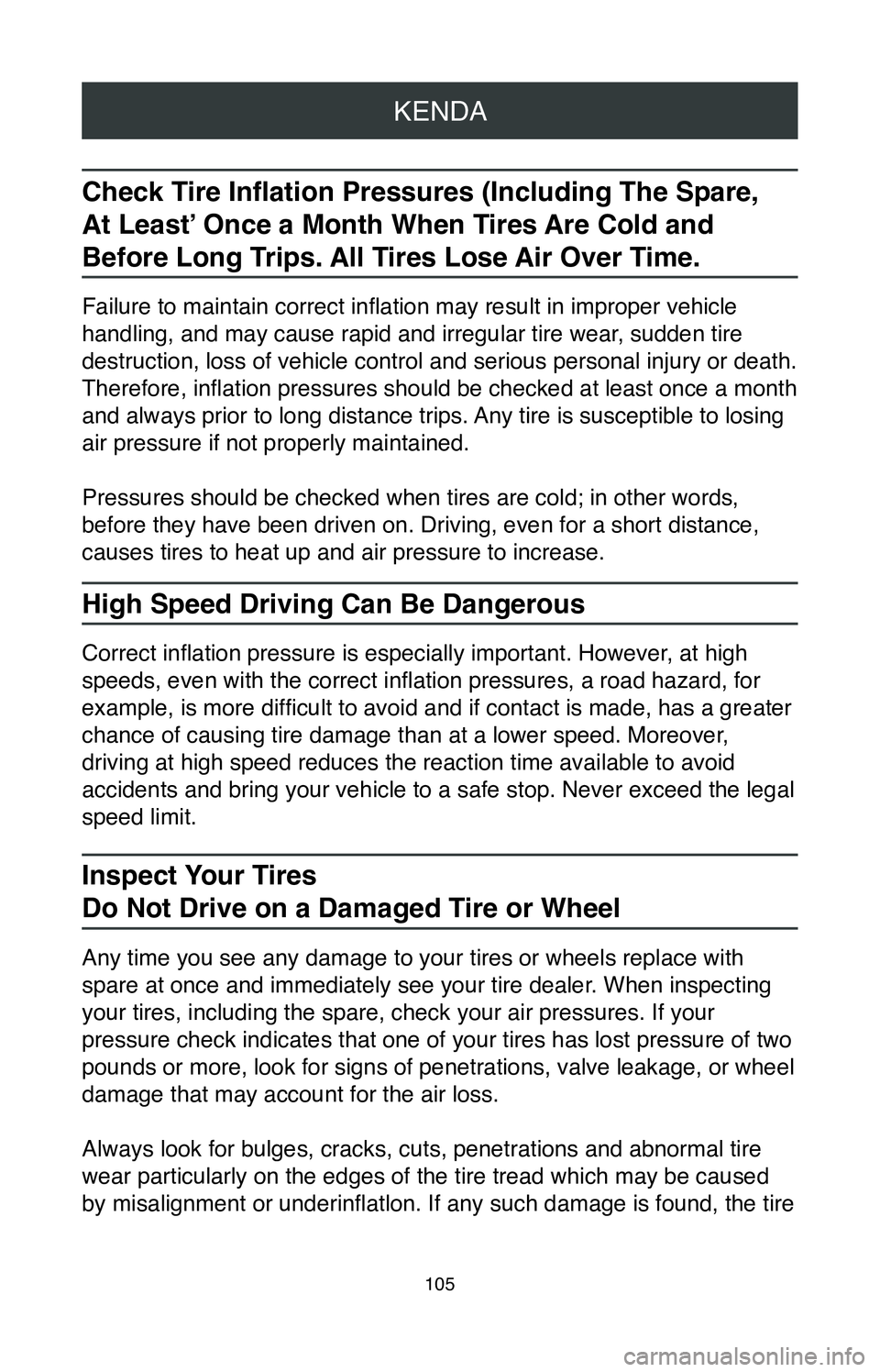
KENDA
105
Check Tire Inflation Pressures (Including The Spare,
At Least’ Once a Month When Tires Are Cold and
Before Long Trips. All Tires Lose Air Over Time.
Failure to maintain correct inflation may result in improper vehicle
handling, and may cause rapid and irregular tire wear, sudden tire
destruction, loss of vehicle control and serious personal injury or death.
Therefore, inflation pressures should be checked at least once a month
and always prior to long distance trips. Any tire is susceptible to losing
air pressure if not properly maintained.
Pressures should be checked when tires are cold; in other words,
before they have been driven on. Driving, even for a short distance,
causes tires to heat up and air pressure to increase.
High Speed Driving Can Be Dangerous
Correct inflation pressure is especially important. However, at high
speeds, even with the correct inflation pressures, a road hazard, for
example, is more difficult to avoid and if contact is made, has a greater
chance of causing tire damage than at a lower speed. Moreover,
driving at high speed reduces the reaction time available to avoid
accidents and bring your vehicle to a safe stop. Never exceed the legal \
speed limit.
Inspect Your Tires
Do Not Drive on a Damaged Tire or Wheel
Any time you see any damage to your tires or wheels replace with
spare at once and immediately see your tire dealer. When inspecting
your tires, including the spare, check your air pressures. If your
pressure check indicates that one of your tires has lost pressure of two\
pounds or more, look for signs of penetrations, valve leakage, or wheel \
damage that may account for the air loss.
Always look for bulges, cracks, cuts, penetrations and abnormal tire
wear particularly on the edges of the tire tread which may be caused
by misalignment or underinflatlon. If any such damage is found, the tire
Page 109 of 260
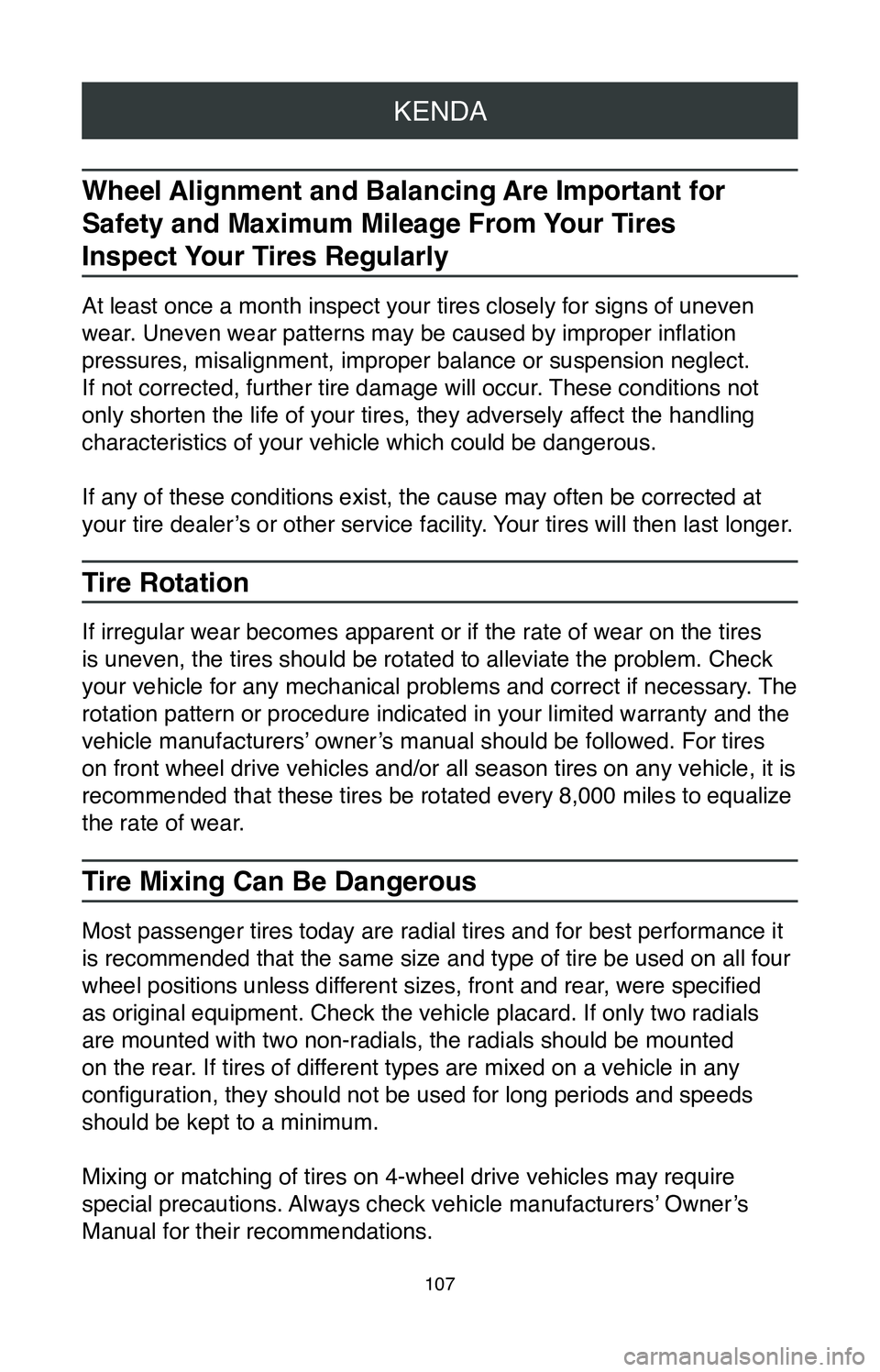
KENDA
107
Wheel Alignment and Balancing Are Important for
Safety and Maximum Mileage From Your Tires
Inspect Your Tires Regularly
At least once a month inspect your tires closely for signs of uneven
wear. Uneven wear patterns may be caused by improper inflation
pressures, misalignment, improper balance or suspension neglect.
If not corrected, further tire damage will occur. These conditions not
only shorten the life of your tires, they adversely affect the handling
characteristics of your vehicle which could be dangerous.
If any of these conditions exist, the cause may often be corrected at
your tire dealer’s or other service facility. Your tires will then last longer.
Tire Rotation
If irregular wear becomes apparent or if the rate of wear on the tires
is uneven, the tires should be rotated to alleviate the problem. Check
your vehicle for any mechanical problems and correct if necessary. The
rotation pattern or procedure indicated in your limited warranty and the\
vehicle manufacturers’ owner’s manual should be followed. For tires
on front wheel drive vehicles and/or all season tires on any vehicle, it\
is
recommended that these tires be rotated every 8,000 miles to equalize
the rate of wear.
Tire Mixing Can Be Dangerous
Most passenger tires today are radial tires and for best performance it \
is recommended that the same size and type of tire be used on all four
wheel positions unless different sizes, front and rear, were specified
as original equipment. Check the vehicle placard. If only two radials
are mounted with two non-radials, the radials should be mounted
on the rear. If tires of different types are mixed on a vehicle in any
configuration, they should not be used for long periods and speeds
should be kept to a minimum.
Mixing or matching of tires on 4-wheel drive vehicles may require
special precautions. Always check vehicle manufacturers’ Owner’s
Manual for their recommendations.
Page 114 of 260
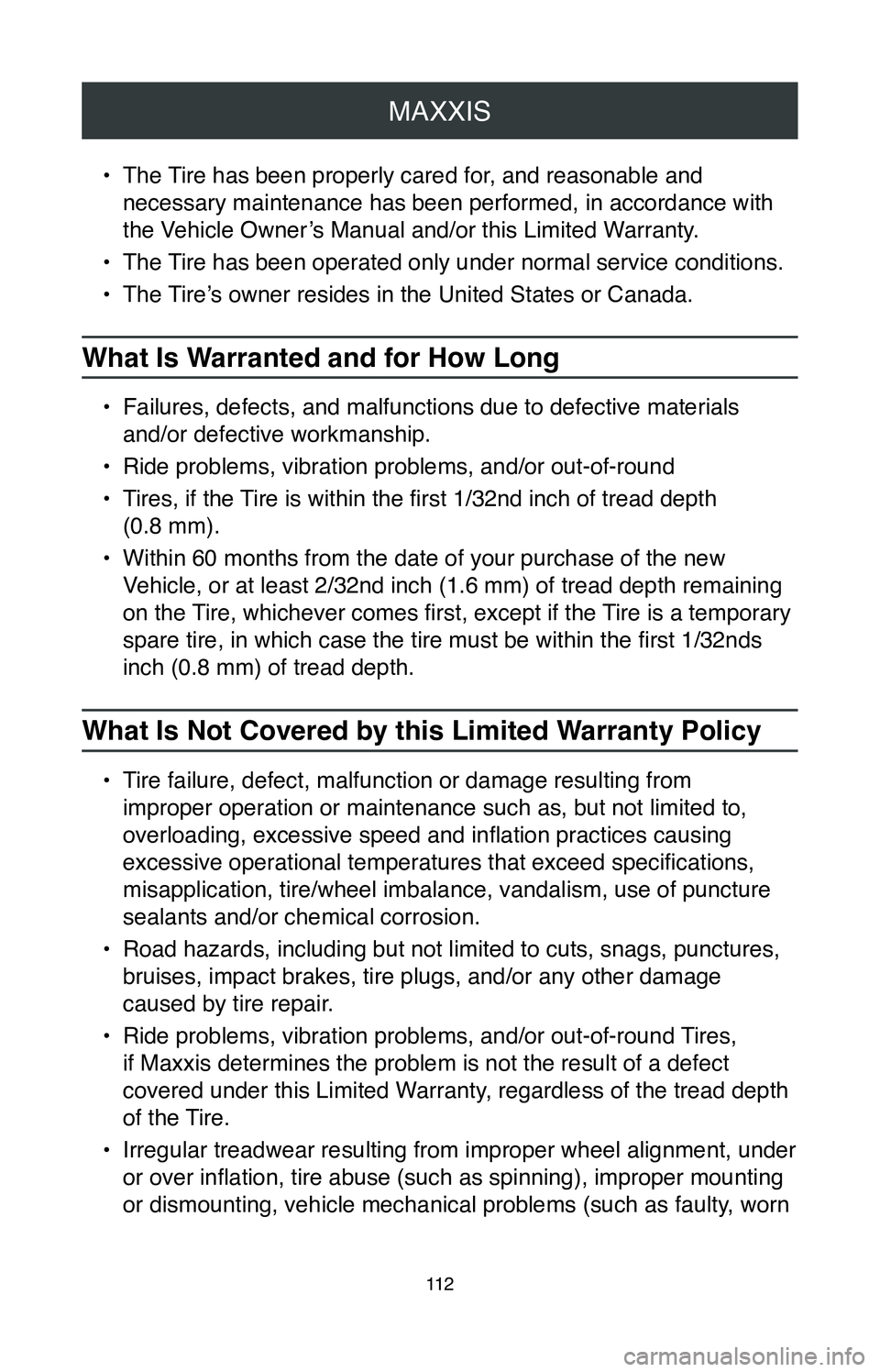
MAXXIS
11 2
• The Tire has been properly cared for, and reasonable and
necessary maintenance has been performed, in accordance with
the Vehicle Owner’s Manual and/or this Limited Warranty.
•
The Tire has been operated only under normal service conditions.
•
The Tire’s owner resides in the United States or Canada.
What Is Warranted and for How Long
• Failures, defects, and malfunctions due to defective materials
and/or defective workmanship.
•
Ride problems, vibration problems, and/or out-of-round
•
Tires, if the Tire is within the first 1/32nd inch of tread depth
(0.8 mm).
•
Within 60 months from the date of your purchase of the new
Vehicle, or at least 2/32nd inch (1.6 mm) of tread depth remaining
on the Tire, whichever comes first, except if the Tire is a temporary
spare tire, in which case the tire must be within the first 1/32nds
inch (0.8 mm) of tread depth.
What Is Not Covered by this Limited Warranty Policy
• Tire failure, defect, malfunction or damage resulting from
improper operation or maintenance such as, but not limited to,
overloading, excessive speed and inflation practices causing
excessive operational temperatures that exceed specifications,
misapplication, tire/wheel imbalance, vandalism, use of puncture
sealants and/or chemical corrosion.
•
Road hazards, including but not limited to cuts, snags, punctures,
bruises, impact brakes, tire plugs, and/or any other damage
caused by tire repair.
•
Ride problems, vibration problems, and/or out-of-round Tires,
if Maxxis determines the problem is not the result of a defect
covered under this Limited Warranty, regardless of the tread depth
of the Tire.
•
Irregular treadwear resulting from improper wheel alignment, under
or over inflation, tire abuse (such as spinning), improper mounting
or dismounting, vehicle mechanical problems (such as faulty, worn
Page 120 of 260
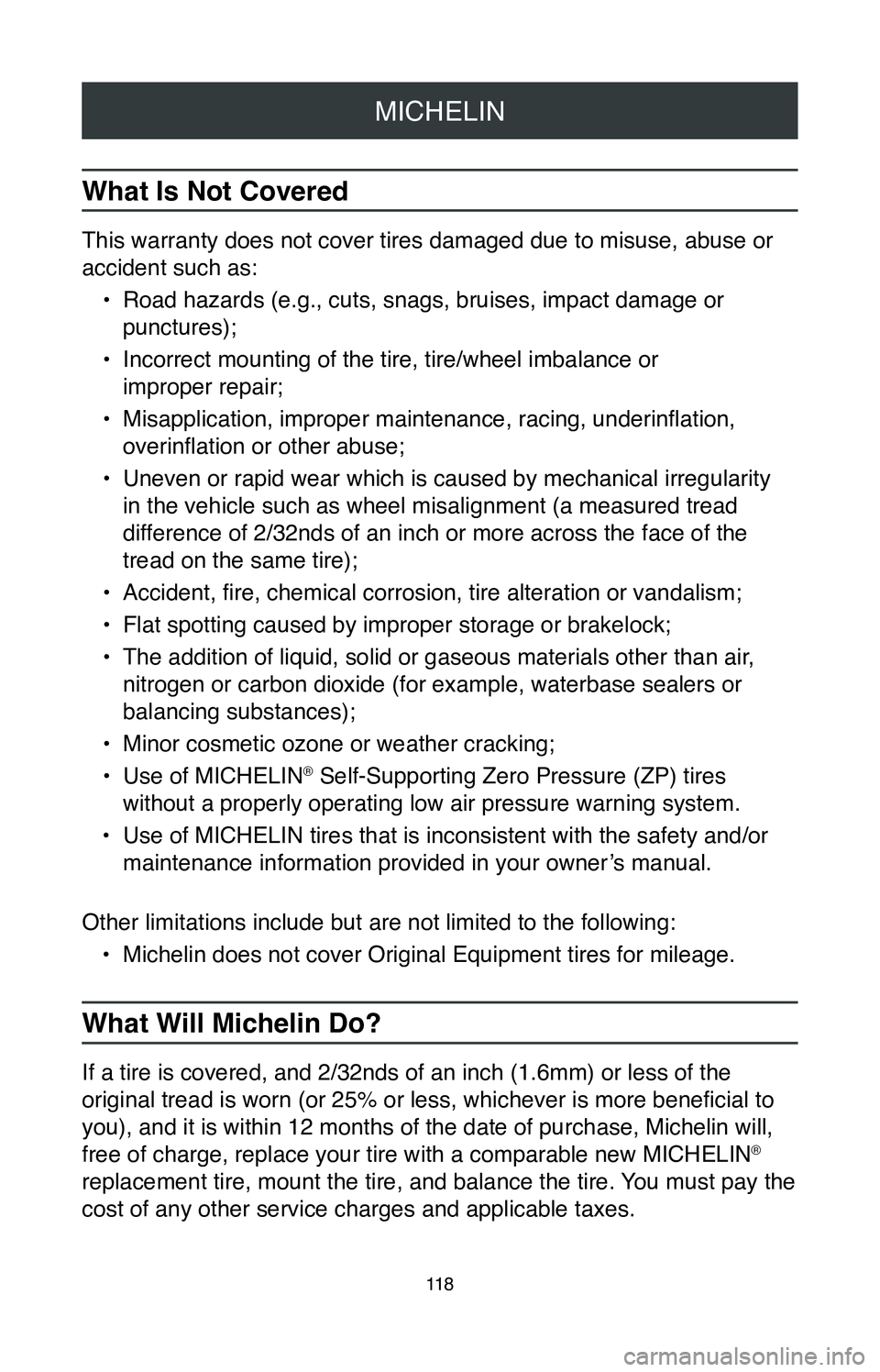
MICHELIN
11 8
What Is Not Covered
This warranty does not cover tires damaged due to misuse, abuse or
accident such as:•
Road hazards (e.g., cuts, snags, bruises, impact damage or
punctures);
•
Incorrect mounting of the tire, tire/wheel imbalance or
improper repair;
•
Misapplication, improper maintenance, racing, underinflation,
overinflation or other abuse;
•
Uneven or rapid wear which is caused by mechanical irregularity
in the vehicle such as wheel misalignment (a measured tread
difference of 2/32nds of an inch or more across the face of the
tread on the same tire);
•
Accident, fire, chemical corrosion, tire alteration or vandalism;
•
Flat spotting caused by improper storage or brakelock;
•
The addition of liquid, solid or gaseous materials other than air,
nitrogen or carbon dioxide (for example, waterbase sealers or
balancing substances);
•
Minor cosmetic ozone or weather cracking;
•
Use of MICHELIN® Self-Supporting Zero Pressure (ZP) tires
without a properly operating low air pressure warning system.
•
Use of MICHELIN tires that is inconsistent with the safety and/or
maintenance information provided in your owner’s manual.
Other limitations include but are not limited to the following: •
Michelin does not cover Original Equipment tires for mileage.
What Will Michelin Do?
If a tire is covered, and 2/32nds of an inch (1.6mm) or less of the
original tread is worn (or 25% or less, whichever is more beneficial to
you), and it is within 12 months of the date of purchase, Michelin will\
,
free of charge, replace your tire with a comparable new MICHELIN
®
replacement tire, mount the tire, and balance the tire. You must pay the
cost of any other service charges and applicable taxes.
Page 136 of 260
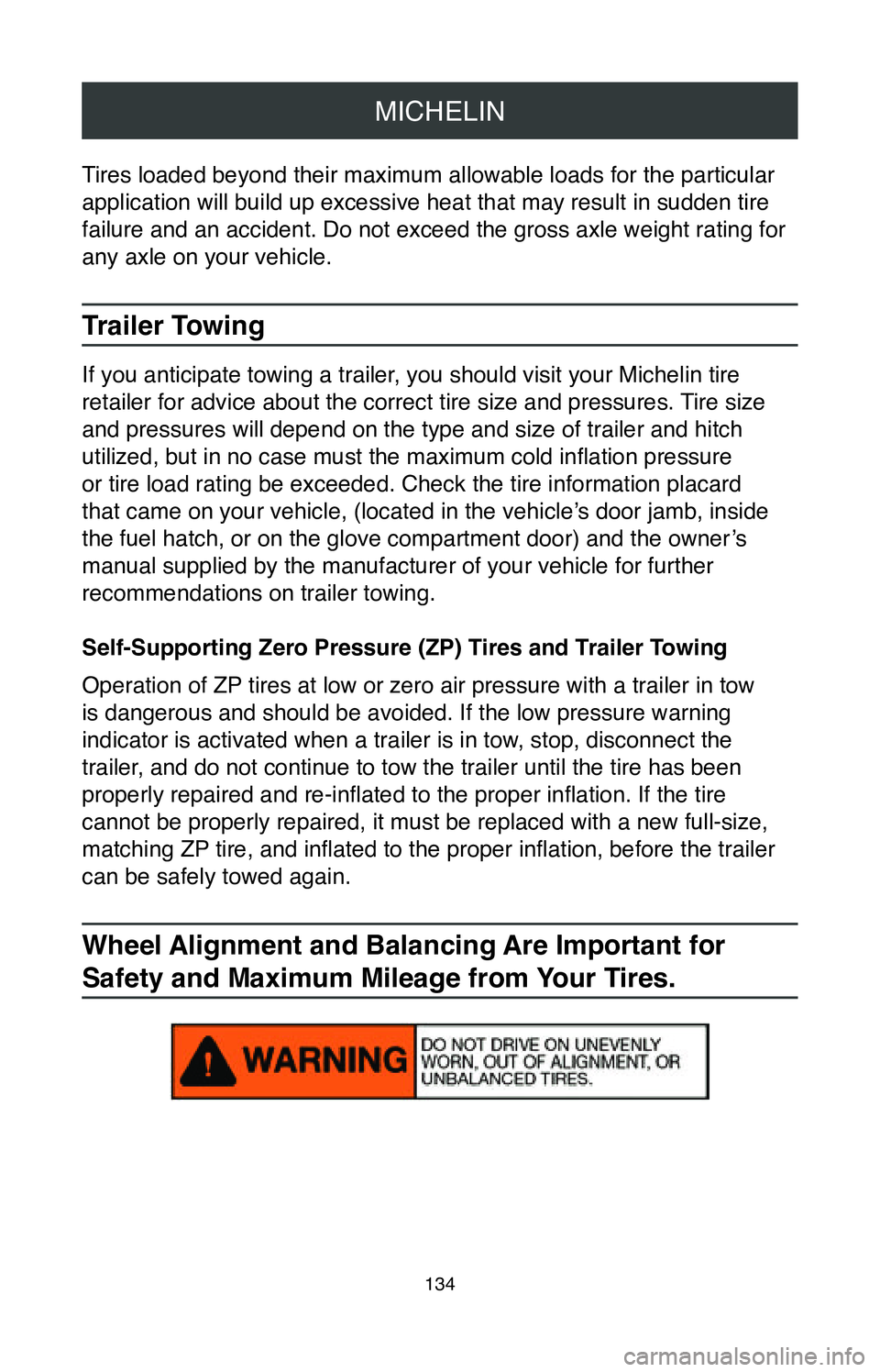
MICHELIN
134
Tires loaded beyond their maximum allowable loads for the particular
application will build up excessive heat that may result in sudden tire \
failure and an accident. Do not exceed the gross axle weight rating for \
any axle on your vehicle.
Trailer Towing
If you anticipate towing a trailer, you should visit your Michelin tire
retailer for advice about the correct tire size and pressures. Tire size
and pressures will depend on the type and size of trailer and hitch
utilized, but in no case must the maximum cold inflation pressure
or tire load rating be exceeded. Check the tire information placard
that came on your vehicle, (located in the vehicle’s door jamb, inside
the fuel hatch, or on the glove compartment door) and the owner’s
manual supplied by the manufacturer of your vehicle for further
recommendations on trailer towing.
Self-Supporting Zero Pressure (ZP) Tires and Trailer Towing
Operation of ZP tires at low or zero air pressure with a trailer in tow
is dangerous and should be avoided. If the low pressure warning
indicator is activated when a trailer is in tow, stop, disconnect the
trailer, and do not continue to tow the trailer until the tire has been
properly repaired and re-inflated to the proper inflation. If the tire
cannot be properly repaired, it must be replaced with a new full-size,
matching ZP tire, and inflated to the proper inflation, before the trailer
can be safely towed again.
Wheel Alignment and Balancing Are Important for
Safety and Maximum Mileage from Your Tires.
Page 137 of 260
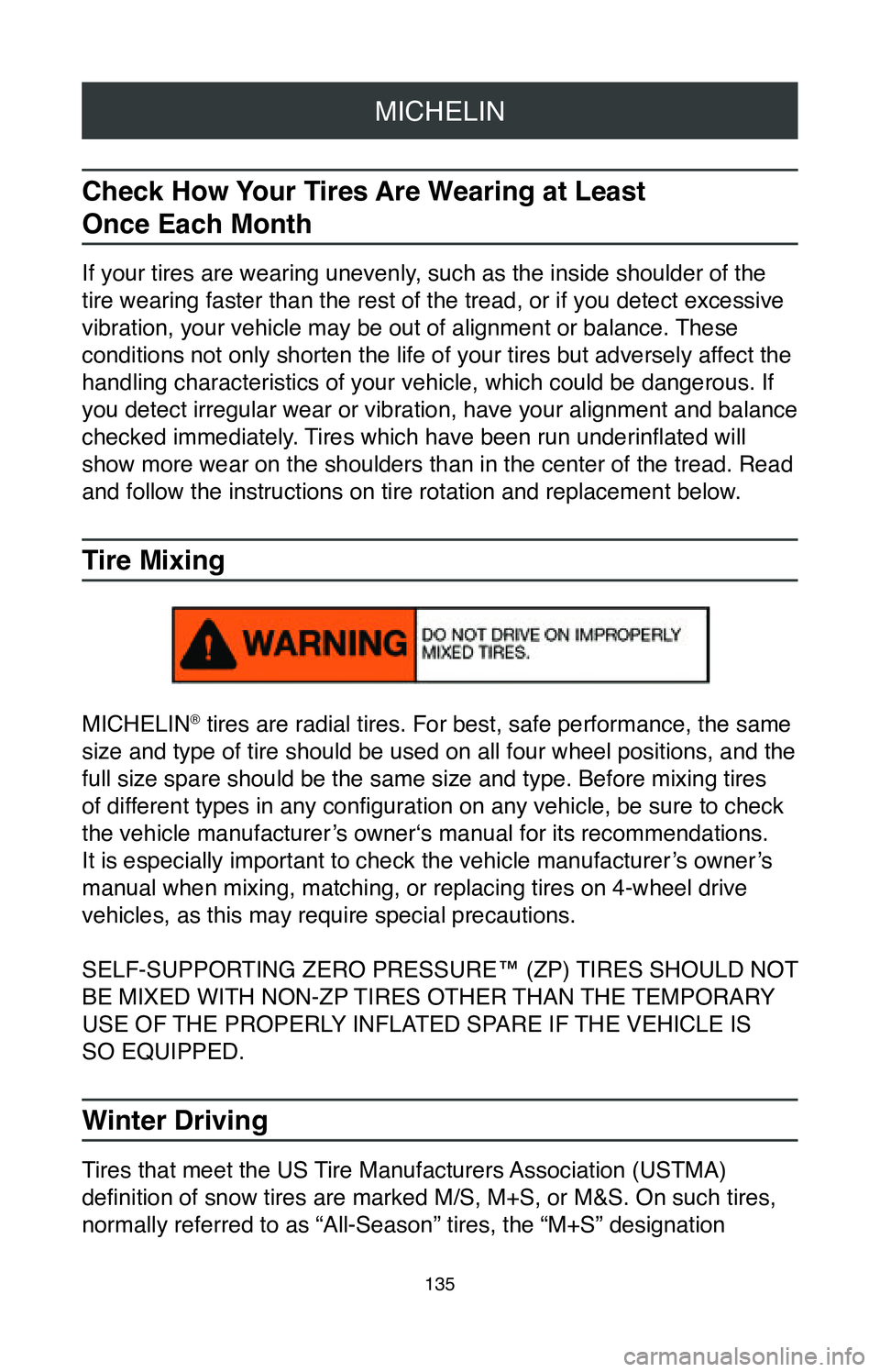
MICHELIN
135
Check How Your Tires Are Wearing at Least
Once Each Month
If your tires are wearing unevenly, such as the inside shoulder of the
tire wearing faster than the rest of the tread, or if you detect excessi\
ve
vibration, your vehicle may be out of alignment or balance. These
conditions not only shorten the life of your tires but adversely affect the
handling characteristics of your vehicle, which could be dangerous. If
you detect irregular wear or vibration, have your alignment and balance
checked immediately. Tires which have been run underinflated will
show more wear on the shoulders than in the center of the tread. Read
and follow the instructions on tire rotation and replacement below.
Tire Mixing
MICHELIN® tires are radial tires. For best, safe performance, the same
size and type of tire should be used on all four wheel positions, and th\
e
full size spare should be the same size and type. Before mixing tires
of different types in any configuration on any vehicle, be sure to check
the vehicle manufacturer’s owner‘s manual for its recommendations.
It is especially important to check the vehicle manufacturer’s owner’s
manual when mixing, matching, or replacing tires on 4-wheel drive
vehicles, as this may require special precautions.
SELF-SUPPORTING ZERO PRESSURE™ (ZP) TIRES SHOULD NOT
BE MIXED WITH NON-ZP TIRES OTHER THAN THE TEMPORARY
USE OF THE PROPERLY INFLATED SPARE IF THE VEHICLE IS
SO EQUIPPED.
Winter Driving
Tires that meet the US Tire Manufacturers Association (USTMA)
definition of snow tires are marked M/S, M+S, or M&S. On such tires,
normally referred to as “All-Season” tires, the “M+S” designation
Page 149 of 260
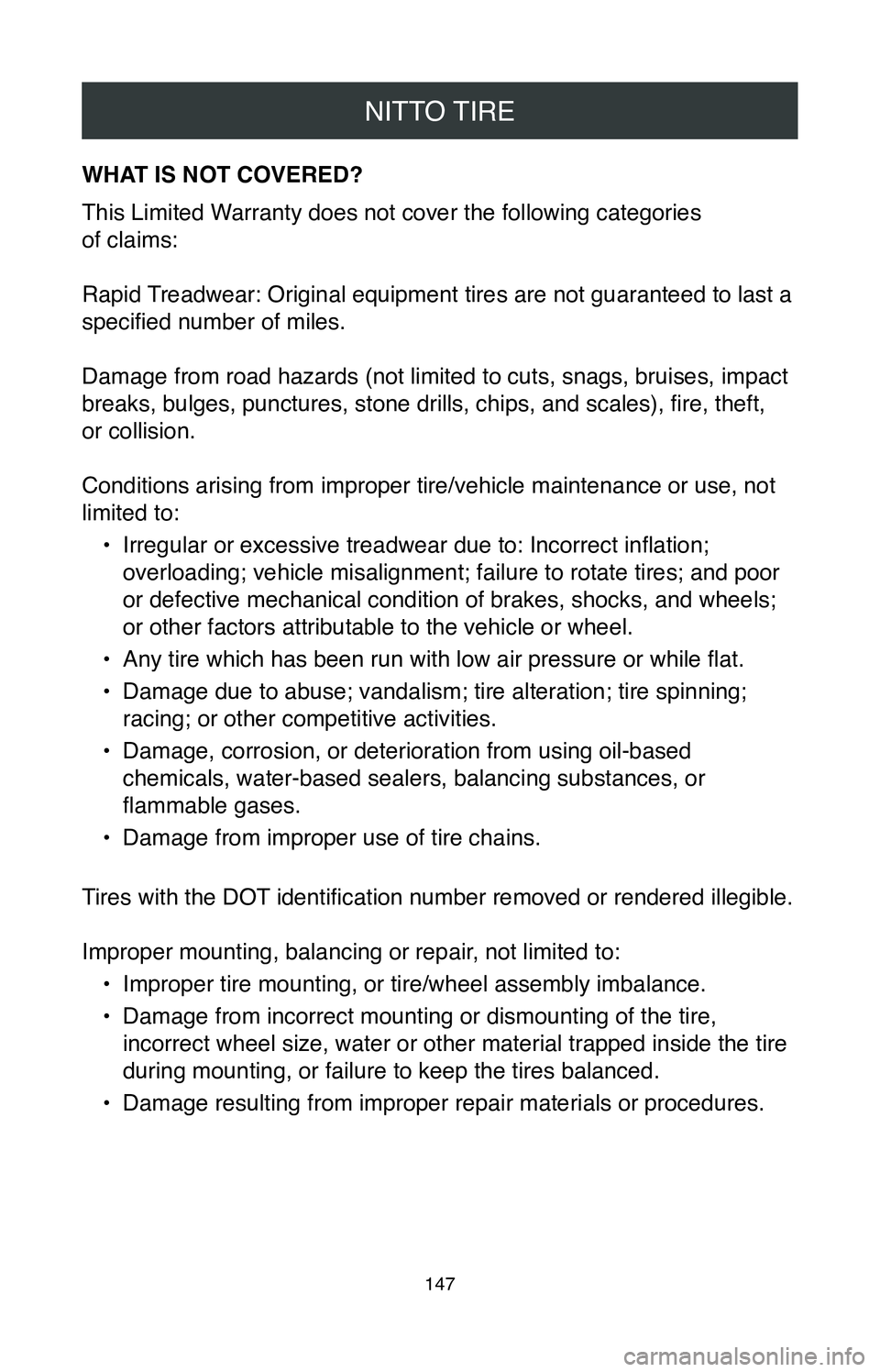
NITTO TIRE
147
WHAT IS NOT COVERED?
This Limited Warranty does not cover the following categories
of claims:
Rapid Treadwear: Original equipment tires are not guaranteed to last a
specified number of miles.
Damage from road hazards (not limited to cuts, snags, bruises, impact
breaks, bulges, punctures, stone drills, chips, and scales), fire, theft,
or collision.
Conditions arising from improper tire/vehicle maintenance or use, not
limited to:
•
Irregular or excessive treadwear due to: Incorrect inflation;
overloading; vehicle misalignment; failure to rotate tires; and poor
or defective mechanical condition of brakes, shocks, and wheels;
or other factors attributable to the vehicle or wheel.
•
Any tire which has been run with low air pressure or while flat.
•
Damage due to abuse; vandalism; tire alteration; tire spinning;
racing; or other competitive activities.
•
Damage, corrosion, or deterioration from using oil-based
chemicals, water-based sealers, balancing substances, or
flammable gases.
•
Damage from improper use of tire chains.
Tires with the DOT identification number removed or rendered illegible.
Improper mounting, balancing or repair, not limited to: •
Improper tire mounting, or tire/wheel assembly imbalance.
•
Damage from incorrect mounting or dismounting of the tire,
incorrect wheel size, water or other material trapped inside the tire
during mounting, or failure to keep the tires balanced.
•
Damage resulting from improper repair materials or procedures.
Page 161 of 260
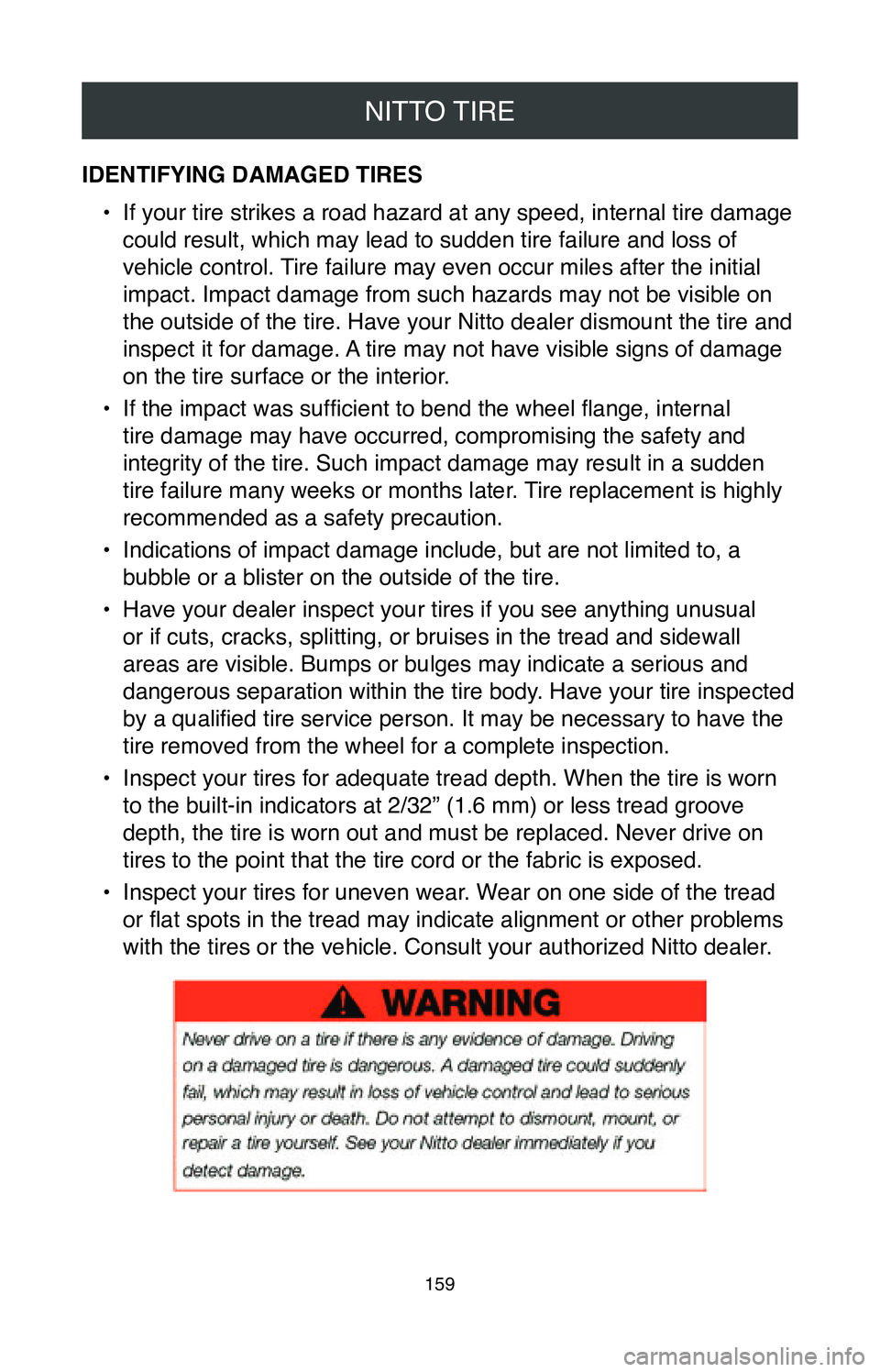
NITTO TIRE
159
IDENTIFYING DAMAGED TIRES•
If your tire strikes a road hazard at any speed, internal tire damage
could result, which may lead to sudden tire failure and loss of
vehicle control. Tire failure may even occur miles after the initial
impact. Impact damage from such hazards may not be visible on
the outside of the tire. Have your Nitto dealer dismount the tire and
inspect it for damage. A tire may not have visible signs of damage
on the tire surface or the interior.
•
If the impact was sufficient to bend the wheel flange, internal
tire damage may have occurred, compromising the safety and
integrity of the tire. Such impact damage may result in a sudden
tire failure many weeks or months later. Tire replacement is highly
recommended as a safety precaution.
•
Indications of impact damage include, but are not limited to, a
bubble or a blister on the outside of the tire.
•
Have your dealer inspect your tires if you see anything unusual
or if cuts, cracks, splitting, or bruises in the tread and sidewall
areas are visible. Bumps or bulges may indicate a serious and
dangerous separation within the tire body. Have your tire inspected
by a qualified tire service person. It may be necessary to have the
tire removed from the wheel for a complete inspection.
•
Inspect your tires for adequate tread depth. When the tire is worn
to the built-in indicators at 2/32” (1.6 mm) or less tread groove
depth, the tire is worn out and must be replaced. Never drive on
tires to the point that the tire cord or the fabric is exposed.
•
Inspect your tires for uneven wear. Wear on one side of the tread
or flat spots in the tread may indicate alignment or other problems
with the tires or the vehicle. Consult your authorized Nitto dealer.
Page 170 of 260
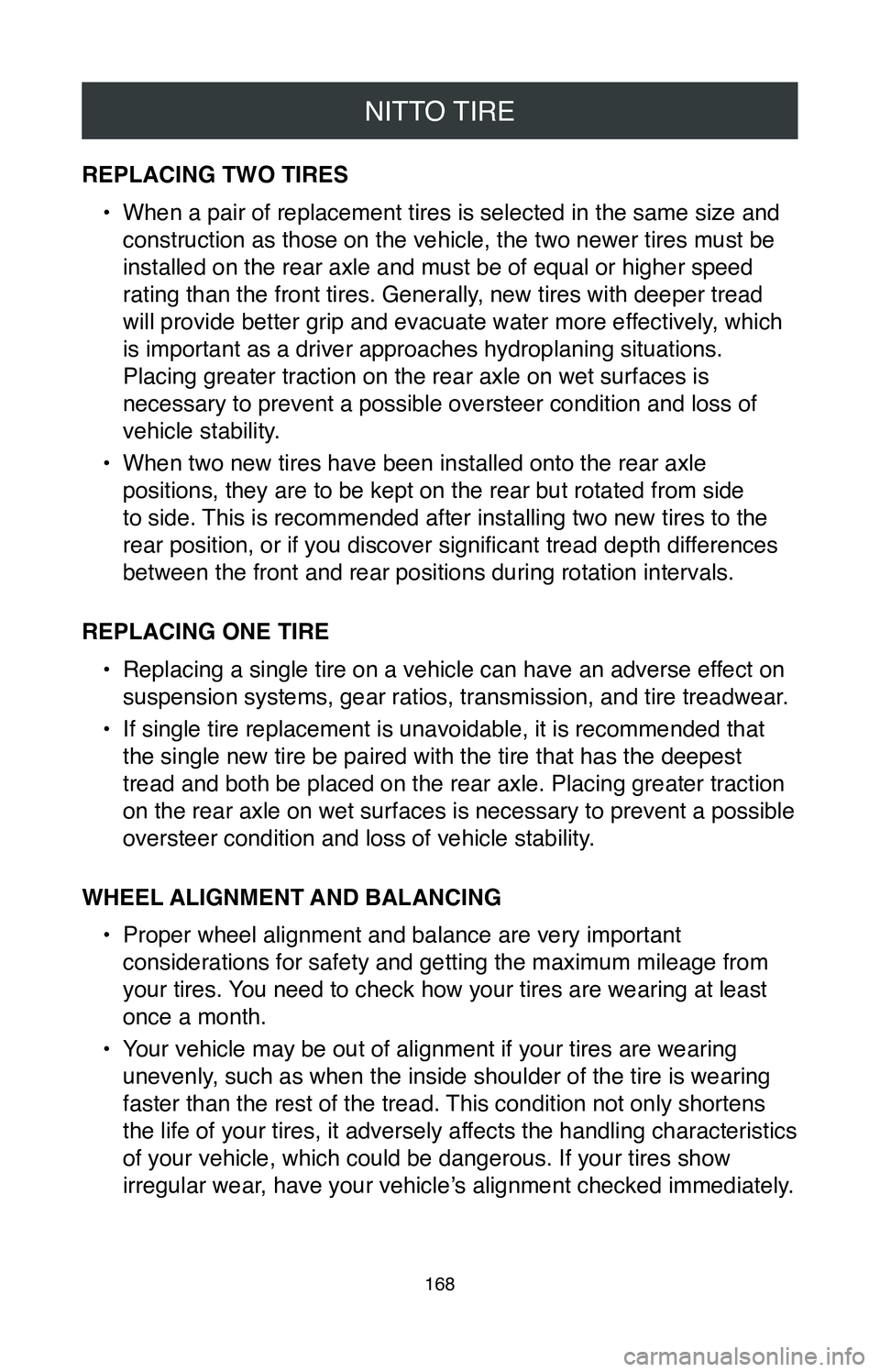
NITTO TIRE
168
REPLACING TWO TIRES•
When a pair of replacement tires is selected in the same size and
construction as those on the vehicle, the two newer tires must be
installed on the rear axle and must be of equal or higher speed
rating than the front tires. Generally, new tires with deeper tread
will provide better grip and evacuate water more effectively, which
is important as a driver approaches hydroplaning situations.
Placing greater traction on the rear axle on wet surfaces is
necessary to prevent a possible oversteer condition and loss of
vehicle stability.
•
When two new tires have been installed onto the rear axle
positions, they are to be kept on the rear but rotated from side
to side. This is recommended after installing two new tires to the
rear position, or if you discover significant tread depth differences
between the front and rear positions during rotation intervals.
REPLACING ONE TIRE •
Replacing a single tire on a vehicle can have an adverse effect on
suspension systems, gear ratios, transmission, and tire treadwear.
•
If single tire replacement is unavoidable, it is recommended that
the single new tire be paired with the tire that has the deepest
tread and both be placed on the rear axle. Placing greater traction
on the rear axle on wet surfaces is necessary to prevent a possible
oversteer condition and loss of vehicle stability.
WHEEL ALIGNMENT AND BALANCING •
Proper wheel alignment and balance are very important
considerations for safety and getting the maximum mileage from
your tires. You need to check how your tires are wearing at least
once a month.
•
Your vehicle may be out of alignment if your tires are wearing
unevenly, such as when the inside shoulder of the tire is wearing
faster than the rest of the tread. This condition not only shortens
the life of your tires, it adversely affects the handling characteristics
of your vehicle, which could be dangerous. If your tires show
irregular wear, have your vehicle’s alignment checked immediately.
Page 172 of 260
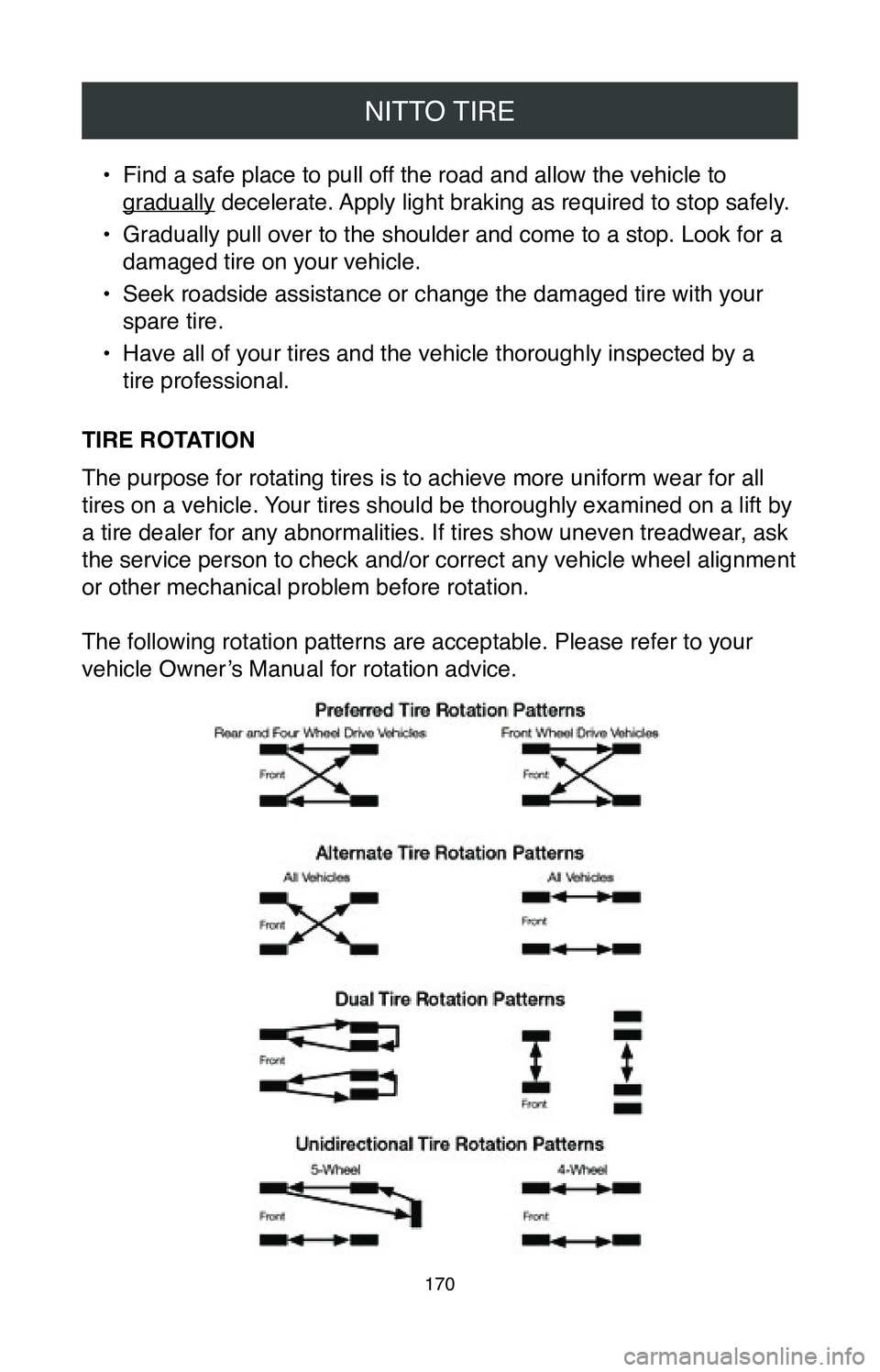
NITTO TIRE
170
• Find a safe place to pull off the road and allow the vehicle to
gradually decelerate. Apply light braking as required to stop safely.
•
Gradually pull over to the shoulder and come to a stop. Look for a
damaged tire on your vehicle.
•
Seek roadside assistance or change the damaged tire with your
spare tire.
•
Have all of your tires and the vehicle thoroughly inspected by a
tire professional.
TIRE ROTATION
The purpose for rotating tires is to achieve more uniform wear for all
tires on a vehicle. Your tires should be thoroughly examined on a lift by
a tire dealer for any abnormalities. If tires show uneven treadwear, ask
the service person to check and/or correct any vehicle wheel alignment
or other mechanical problem before rotation.
The following rotation patterns are acceptable. Please refer to your
vehicle Owner’s Manual for rotation advice.